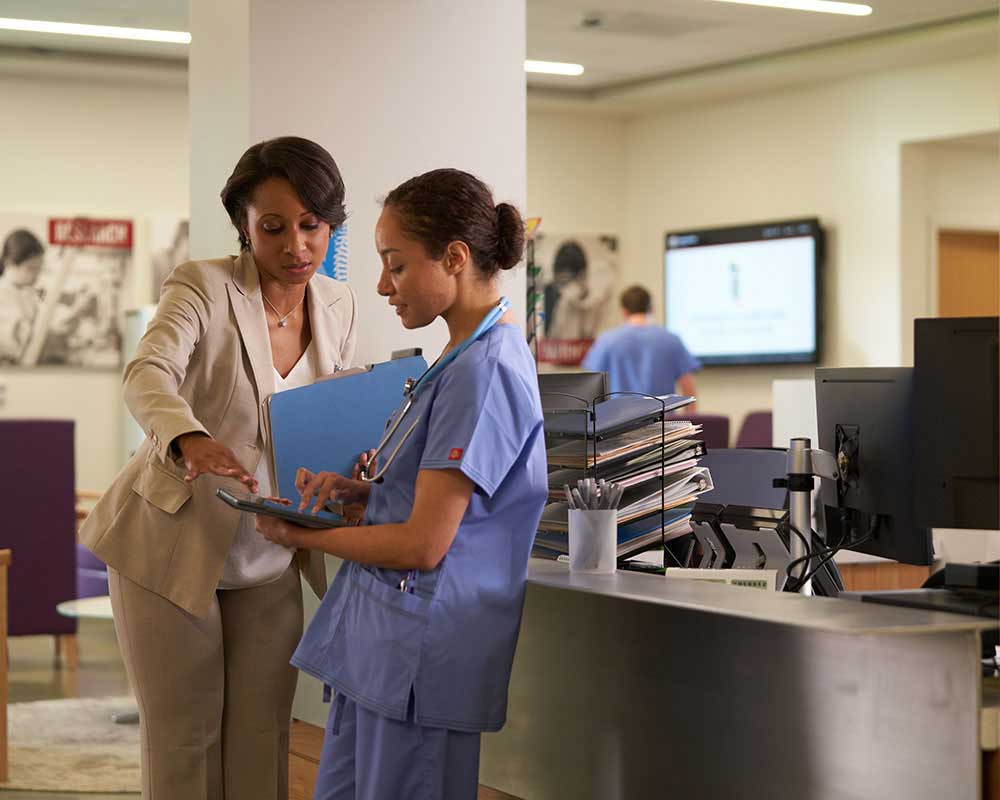Understanding the Trick Duties and Responsibilities in Medical Administration
Understanding the Trick Duties and Responsibilities in Medical Administration
Blog Article
Finest Practices in Medical Management for Improving Effectiveness and Decreasing Prices
In the ever-evolving landscape of health care, the quest of ideal practices in medical administration is vital for enhancing performance and suppressing costs. By incorporating advanced innovations such as electronic wellness records and telemedicine, healthcare providers can improve procedures and improve patient treatment.
Leveraging Advanced Innovation
The combination of electronic remedies into health care systems has actually transformed the way centers operate, improving processes and enhancing individual treatment. By centralizing individual details, EHRs eliminate the requirement for cumbersome documents and help with smooth interaction amongst medical care service providers.
Telemedicine is an additional technical improvement that has actually changed individual communication. It provides benefit for both clients and health care experts by making it possible for remote appointments, which can lower the requirement for in-person check outs and maximize appointment organizing. Additionally, telehealth systems can extend healthcare accessibility to country or underserved areas, connecting voids in care shipment.
Moreover, making use of Expert system (AI) and maker learning is becoming progressively prevalent in anticipating analytics, allowing for early discovery of prospective health concerns and even more informed decision-making. These technologies, when incorporated effectively, can improve diagnostic accuracy and customize individual treatment strategies, eventually leading to boosted medical care results and functional efficiency.
Optimizing Source Appropriation
By strategically taking care of sources such as employees, devices, and finances, health care facilities can dramatically boost their functional performance, boost individual results, and lower unneeded expenditures. The very first step in optimizing source allotment involves performing a comprehensive analysis of present properties and recognizing locations where resources may be underutilized or overextended.
Focusing on source allotment based on person requirements and solution demands is necessary. This involves lining up resources with high-demand areas, such as emergency situation treatment or specialized treatments, to make sure prompt and reliable person treatment. Implementing versatile staffing versions can additionally enhance labor sources by adjusting employees allotment in feedback to varying patient quantities. Additionally, accepting telemedicine and various other technological options can relieve physical source restraints by using alternative methods for patient-provider communications.
Economic sources should be meticulously checked and assigned with tactical insight to sustain both temporary functional requirements and lasting institutional objectives. This consists of investing in training programs that enhance staff competencies and taking on energy-efficient methods that minimize functional costs (medical administration). Ultimately, a maximized source allotment approach cultivates a sustainable healthcare setting that is responsive, reliable, and economically prudent
Streamlining Operations Processes
When medical care facilities aim to improve operational effectiveness, streamlining workflow processes comes to be a pivotal focus. Efficient process decrease redundancy, get rid of unneeded actions, and enhance sychronisation among healthcare professionals. This technique not just increases service distribution yet additionally enhances the top quality of client treatment.

Following, innovation assimilation plays a significant function in streamlining process. Implementing digital health and wellness documents (EHRs) and digital medical professional order entry (CPOE) systems lowers documents, lessens human mistake, and guarantees info comes to all appropriate workers. In addition, leveraging telemedicine systems can improve individual examinations and follow-ups, lowering the strain on physical framework.

Eventually, streamlined process result in set you back decreases and boosted person complete satisfaction, promoting a much more lasting healthcare atmosphere.
Enhancing Data Monitoring
Structure upon structured process, optimizing data management comes to be a crucial element in progressing medical care management. Efficient data monitoring systems are vital for maintaining precise client documents, improving decision-making, and making sure compliance with regulative standards. By carrying out robust data management options, healthcare facilities can improve the quality of individual care while all at once lowering functional costs.
One key facet of enhancing data monitoring is the combination of innovative electronic health and wellness document (EHR) systems. view it now These systems assist in the smooth exchange of client details across various divisions, minimizing duplication of tests and reducing errors. A well-designed EHR system sustains data analytics, allowing doctor to determine trends and make educated choices regarding individual care.
Furthermore, securing client information is paramount. Embracing extensive cybersecurity steps, consisting of encryption and routine audits, makes certain the stability and discretion of delicate information. This not only shields clients but additionally preserves the establishment's track record.
Purchasing personnel training is one more vital variable. Informing medical care professionals on information management practices improves their ability to efficiently make use of modern technology, bring about improved individual results. In verdict, boosting information management with sophisticated innovation and extensive training is necessary for attaining effectiveness and price decrease in medical management.
Fostering Collaborative Communication
A vital part in advancing clinical administration is cultivating collective interaction amongst health care specialists. Efficient interaction is vital for ensuring seamless person care, maximizing treatment end results, and minimizing mistakes. By urging open a fantastic read discussion and coordination across multidisciplinary groups, health care companies can boost their operational efficiency and reduce unnecessary costs.
Central to this strategy is the combination of communication technologies such as electronic health documents (EHRs) and secure messaging platforms, which promote the fast exchange of important client information. These devices enable doctor to access and share data in actual time, making sure that all staff member are informed and straightened in their decision-making procedures. Regular team meetings and interdisciplinary rounds can additionally promote a society of collaboration and accountability.
Training programs concentrated on improving communication abilities are likewise essential. These programs can assist staff establish the capacity to convey information plainly and pay attention actively, therefore lowering misconceptions and fostering an encouraging work environment. On top of that, taking on standardized interaction protocols, such as SBAR (Scenario, History, Analysis, Recommendation), can improve the exchange of details, ensuring that important information are shared succinctly and successfully. Eventually, promoting collaborative interaction causes enhanced medical care distribution and cost financial savings (medical administration).

Final Thought
Including innovative modern technology, such as digital health and wellness records and telemedicine, alongside maximized resource allocation and structured operations processes, is essential for enhancing performance in clinical administration. Reliable information management and cultivating collective communication amongst health care teams are vital for reducing redundancies and enhancing care high quality. By focusing on precautionary treatment and taking part in quality renovation efforts, health care organizations can achieve considerable expense financial savings and enhanced person end results, thus making sure sustainable medical care distribution in an increasingly complicated environment.
Report this page